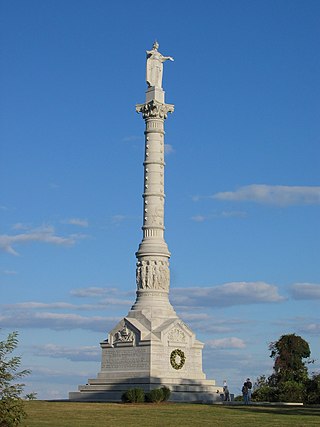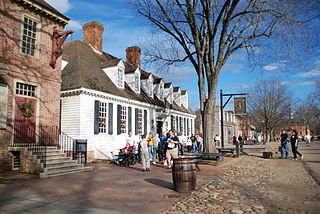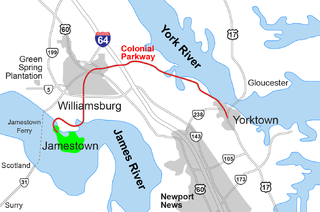
The Jamestown settlement in the Colony of Virginia was the first permanent English settlement in the Americas. It was located on the northeast bank of the James River, about 2.5 mi (4 km) southwest of present-day Williamsburg. It was established by the London Company as "James Fort" on May 4, 1607 O.S., and considered permanent, after brief abandonment in 1610. It followed failed attempts, including the Roanoke Colony, established in 1585. Despite the dispatch of more supplies, only 60 of the original 214 settlers survived the 1609–1610 Starving Time. In mid-1610, the survivors abandoned Jamestown, though they returned after meeting a resupply convoy in the James River.

Jamestown Settlement is a living history museum operated by the Commonwealth of Virginia, created in 1957 as Jamestown Festival Park for the 350th anniversary celebration. Today it includes a recreation of the original James Fort, a Powhatan Native American town, indoor and outdoor displays, and replicas of the original settlers' ships: the Susan Constant, Godspeed, and Discovery.

York County is a county in the eastern part of the Commonwealth of Virginia, located in the Tidewater. As of the 2020 census, the population was 70,045. The county seat is the unincorporated town of Yorktown.

Williamsburg is an independent city in Virginia, United States. As of the 2020 census, it had a population of 15,425. Located on the Virginia Peninsula, Williamsburg is in the northern part of the Hampton Roads metropolitan area. It is bordered by James City County on the west and south and York County on the east.

James City County is a county located in the Commonwealth of Virginia. As of the 2020 census, the population was 78,254. Although politically separate from the county, the county seat is the adjacent independent city of Williamsburg.

Yorktown is a town in York County, Virginia. It is the county seat of York County, one of the eight original shires formed in colonial Virginia in 1682. Yorktown's population was 195 as of the 2010 census, while York County's population was 66,134 in the 2011 census estimate.

The House of Burgesses was the lower house of the Virginia General Assembly from 1619 to 1776. It existed during the colonial history of the United States when Virginia was a British colony. From 1642 to 1776, the House of Burgesses was an important feature of Virginian politics, alongside the Crown-appointed colonial governor and the Virginia Governor's Council, the upper house of the General Assembly.

The Virginia Peninsula is located in southeast Virginia, bounded by the York River, James River, Hampton Roads and Chesapeake Bay. It is sometimes known as the Lower Peninsula to distinguish it from two other peninsulas to the north, the Middle Peninsula and the Northern Neck.

Colonial National Historical Park is a large national historical park located in the Hampton Roads region of Virginia operated by the National Park Service. It protects and interprets several sites relating to the Colony of Virginia and the history of the United States more broadly. These range from the site of the first English settlement at Jamestown, to the battlefields of Yorktown where the British Army was defeated in the American Revolutionary War. Over 3 million people visit the park each year.

Colonial Williamsburg is a living-history museum and private foundation presenting a part of the historic district in the city of Williamsburg, Virginia. Its 301-acre (122 ha) historic area includes several hundred restored or recreated buildings from the 18th century, when the city was the capital of the Colony of Virginia; 17th-century, 19th-century, and Colonial Revival structures; and more recent reconstructions. The historic area includes three main thoroughfares and their connecting side streets that attempt to suggest the atmosphere and the circumstances of 18th-century Americans. Costumed employees work and dress as people did in the era, sometimes using colonial grammar and diction.

William Archer Rutherfoord "W. A. R." Goodwin was an Episcopal priest, historian, and author. As the rector of Bruton Parish Church, Goodwin began the 20th-century preservation and restoration effort which resulted in Colonial Williamsburg in Virginia. He is thus sometimes called "the Father of the Restoration of Colonial Williamsburg."

The Historic Triangle includes three historic colonial communities located on the Virginia Peninsula, bounded by the York River on the north and James River on the south. The three points that form the triangle are Jamestown, Colonial Williamsburg, and Yorktown. They feature many restored attractions and are linked by the Colonial Parkway in James City and York counties, and the City of Williamsburg.

Jamestown 2007 is the name of the organization which planned the events commemorating the 400th anniversary (quadricentennial) of the founding of Jamestown, Virginia in 1607, the first permanent English-speaking settlement in what is now the United States of America. America's 400th Anniversary was an 18-month-long commemoration including 10 Signature Events, hundreds of community programs and dozens of partner and programs and events. Activities took place throughout Virginia, in major cities along the East Coast, and in the United Kingdom.

Grove is an unincorporated community in the southeastern portion of James City County in the Virginia Peninsula subregion of Virginia in the United States. It is located in the center of the Historic Triangle of Colonial Virginia, communities linked by the Colonial Parkway. This area is one of the busiest tourist destinations in the world.

Historic Jamestown is the cultural heritage site that was the location of the 1607 James Fort and the later 17th-century town of Jamestown in America. It is located on Jamestown Island, on the James River at Jamestown, Virginia, and operated as a partnership between Preservation Virginia and the U.S. National Park Service as part of Colonial National Historical Park.
Parke Shepherd Rouse Jr. was an American journalist, writer and historian in Tidewater Virginia.

The history of Williamsburg, Virginia dates to the 17th Century. First named Middle Plantation, it changed its name to Williamsburg in 1699.

The history of Hampton Roads dates to 1607, when Jamestown was founded. Two wars have taken place in addition to many other historical events.

The President's House is the residence of the President of the College of William & Mary in Williamsburg, Virginia. Constructed in 1732, the building still serves its original purpose and is among the oldest buildings in Virginia. Since its construction only one of the college's presidents, Robert Saunders Jr., has not moved into the building, which is let for free to the president. The President's House is William & Mary's third-oldest building and the oldest official college presidential residence in the United States.
Elizabeth Jaquelin Ambler Brent Carrington also known as Betsy Ambler Carrington founded the Female Humane Association in Richmond, Virginia. It is now known as the Memorial Foundation for Children. Believed to be the first of its kind in Virginia, the organization provided safety and shelter to destitute girls and kept they from a life of poverty and the possibility of becoming prostitutes to survive.


















